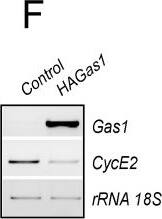Mouse Gas1 Antibody
R&D Systems, part of Bio-Techne | Catalog # AF2644


Key Product Details
Species Reactivity
Validated:
Cited:
Applications
Validated:
Cited:
Label
Antibody Source
Product Specifications
Immunogen
Leu39-Ser315
Accession # Q01721
Specificity
Clonality
Host
Isotype
Scientific Data Images for Mouse Gas1 Antibody
Gas1 in Mouse Embryo.
Gas1 was detected in immersion fixed frozen sections of mouse embryo (13 d.p.c.) using Goat Anti-Mouse Gas1 Antigen Affinity-purified Polyclonal Antibody (Catalog # AF2644) at 5 µg/mL overnight at 4 °C. Tissue was stained using the Anti-Goat HRP-DAB Cell & Tissue Staining Kit (brown; Catalog # CTS008) and counterstained with hematoxylin (blue). Specific staining was localized to developing brain. View our protocol for Chromogenic IHC Staining of Frozen Tissue Sections.Detection of Mouse Gas1 by Immunocytochemistry/Immunofluorescence
Immunofluorescent staining of E15.5 Wild type HoxAADD (a–d) and mutant Hoxaadd (Hoxa9,10,11−/−;Hoxd9,10,11−/−) (e–h) forelimbs. Arrowhead: radius, Arrow: ulna, the autopod is oriented to the left of the image. a and e: Six2 immunostaining, showing an increased expression in mutant chondrocytes. b and f: Gas1 staining, showing an increase in mutant limbs that is restricted to cells flanking chondrocytes, consistent with the inclusion of some perichondrial cells in the LCM samples. c and g: Lef1 staining, showing an absence of staining in mutant chondrocytes. d and h: Runx3 staining, showing an absence of staining in mutant chondrocytes Image collected and cropped by CiteAb from the following publication (https://pubmed.ncbi.nlm.nih.gov/26186931), licensed under a CC-BY license. Not internally tested by R&D Systems.Detection of Mouse Gas1 by Immunocytochemistry/Immunofluorescence
Immunofluorescent staining of E15.5 Wild type HoxAADD (a–d) and mutant Hoxaadd (Hoxa9,10,11−/−;Hoxd9,10,11−/−) (e–h) forelimbs. Arrowhead: radius, Arrow: ulna, the autopod is oriented to the left of the image. a and e: Six2 immunostaining, showing an increased expression in mutant chondrocytes. b and f: Gas1 staining, showing an increase in mutant limbs that is restricted to cells flanking chondrocytes, consistent with the inclusion of some perichondrial cells in the LCM samples. c and g: Lef1 staining, showing an absence of staining in mutant chondrocytes. d and h: Runx3 staining, showing an absence of staining in mutant chondrocytes Image collected and cropped by CiteAb from the following publication (https://pubmed.ncbi.nlm.nih.gov/26186931), licensed under a CC-BY license. Not internally tested by R&D Systems.Applications for Mouse Gas1 Antibody
Immunohistochemistry
Sample: Immersion fixed frozen sections of mouse embryo (13 d.p.c.)
Western Blot
Sample: Recombinant Mouse Gas1 (Catalog # 2644-GS)
Mouse Gas1 Sandwich Immunoassay
Reviewed Applications
Read 3 reviews rated 5 using AF2644 in the following applications:
Formulation, Preparation, and Storage
Purification
Reconstitution
Formulation
Shipping
Stability & Storage
- 12 months from date of receipt, -20 to -70 °C as supplied.
- 1 month, 2 to 8 °C under sterile conditions after reconstitution.
- 6 months, -20 to -70 °C under sterile conditions after reconstitution.
Background: Gas1
Gas1 (Growth Arrest Specific 1) is one of six structurally unrelated proteins that were identified by their increased expression in growth-arrested cells relative to actively proliferating cells (1, 2). Following mitogenic stimulation, Gas1 expression is transcriptionally suppressed by c-Myc as cells transit from G0 to G1 phases of the cell cycle (3, 4). Overexpression of Gas1 prevents S phase entry and DNA synthesis (5). Gas1-mediated blockade of the cell cycle is p53-dependent but does not require the transactivating domain of p53 (6). The mouse Gas1 cDNA encodes a 343 amino acid (aa) precursor that includes a 38 aa signal sequence, a 277 aa mature protein, and a 28 aa C-terminal propeptide. Gas1 contains Ala-rich and Asp-rich regions as well as an RGD sequence (5). Mature mouse and human Gas1 share 85% aa sequence identity. Mouse Gas1 is a 40 kDa GPI linked glycoprotein that is uniformly distributed on the cell surface (7). In contact inhibited vascular endothelial cells, Gas1 is induced by VE-Cadherin and VEGF expression and mediates the anti-apoptotic effect of VEGF (8). In contrast, Gas1 is induced in hippocampal neurons after NMDA exposure but functions as a pro-apoptotic effector of NMDA-mediated excitotoxicity (9). Gas1 exhibits a range of developmental effects including either promoting or inhibiting growth and differentiation of somite, limb, cerebellar, and eye tissues (10‑14). Gas1 mediates the antagonistic effect of Wnt proteins toward Shh function by binding the N-terminal region of Shh (11). The dependence of Gas1 functions on the cellular context has been addressed by suggesting that Gas1 could function as a co-receptor for GDNF family ligands (15). This speculation is supported by R&D Systems’ data that demonstrate direct binding of Gas1 to Artemin and Neurturin.
References
- Schneider, C. et al. (1988) Cell 54:787.
- Mullor, J.L. and A.R. Altaba (2002) BioEssays 24:22.
- Del Sal, G. et al. (1994) Proc. Natl. Acad. Sci. USA 91:1848.
- Lee, T.C. et al. (1997) Proc. Natl. Acad. Sci. USA 94:12886.
- Del Sal, G. et al. (1992) Cell 70:595.
- Del Sal, G. et al. (1995) Mol. Cell. Biol. 15:7152.
- Stebel, M. et al. (2000) FEBS Lett. 481:152.
- Spagnuolo, R. et al. (2004) Blood 103:3005.
- Mellstrom, B. et al. (2002) Mol. Cell Neurosci. 19:417.
- Lee, K.K.H. et al. (2001) Dev. Biol. 234:188.
- Lee, C.S. et al. (2001) Proc. Natl. Acad. Sci. USA 98:11347.
- Liu, Y. et al. (2002) Development 129:5289.
- Liu, Y. et al. (2001) Dev. Biol. 236:30.
- Lee, C.S. et al. (2001) Dev. Biol. 236:17.
- Schueler-Furman, O. et al. (2006) Trends Pharmacol. Sci. 27:72.
Long Name
Alternate Names
Gene Symbol
UniProt
Additional Gas1 Products
Product Documents for Mouse Gas1 Antibody
Product Specific Notices for Mouse Gas1 Antibody
For research use only


